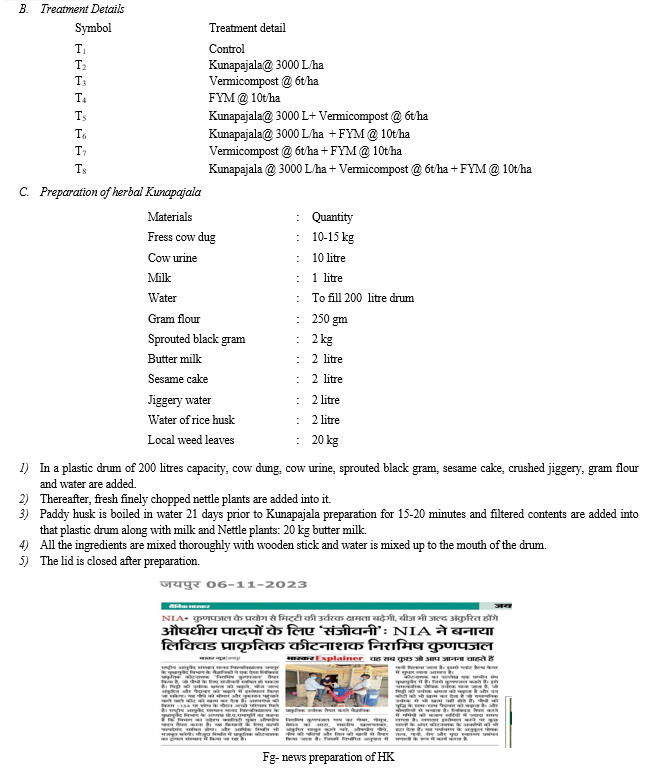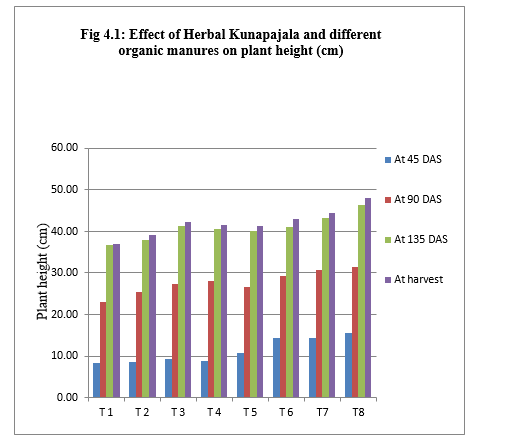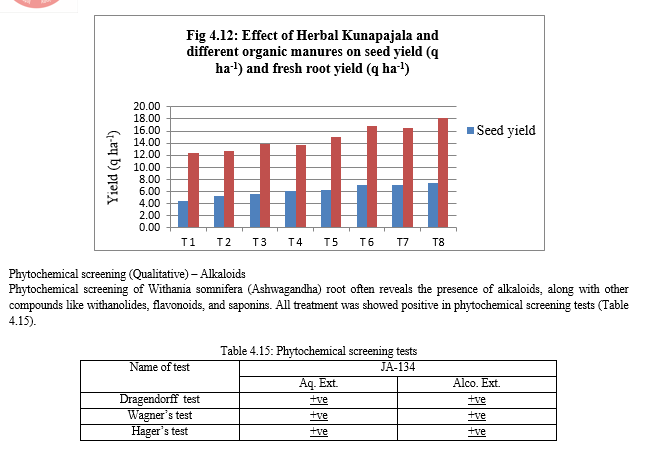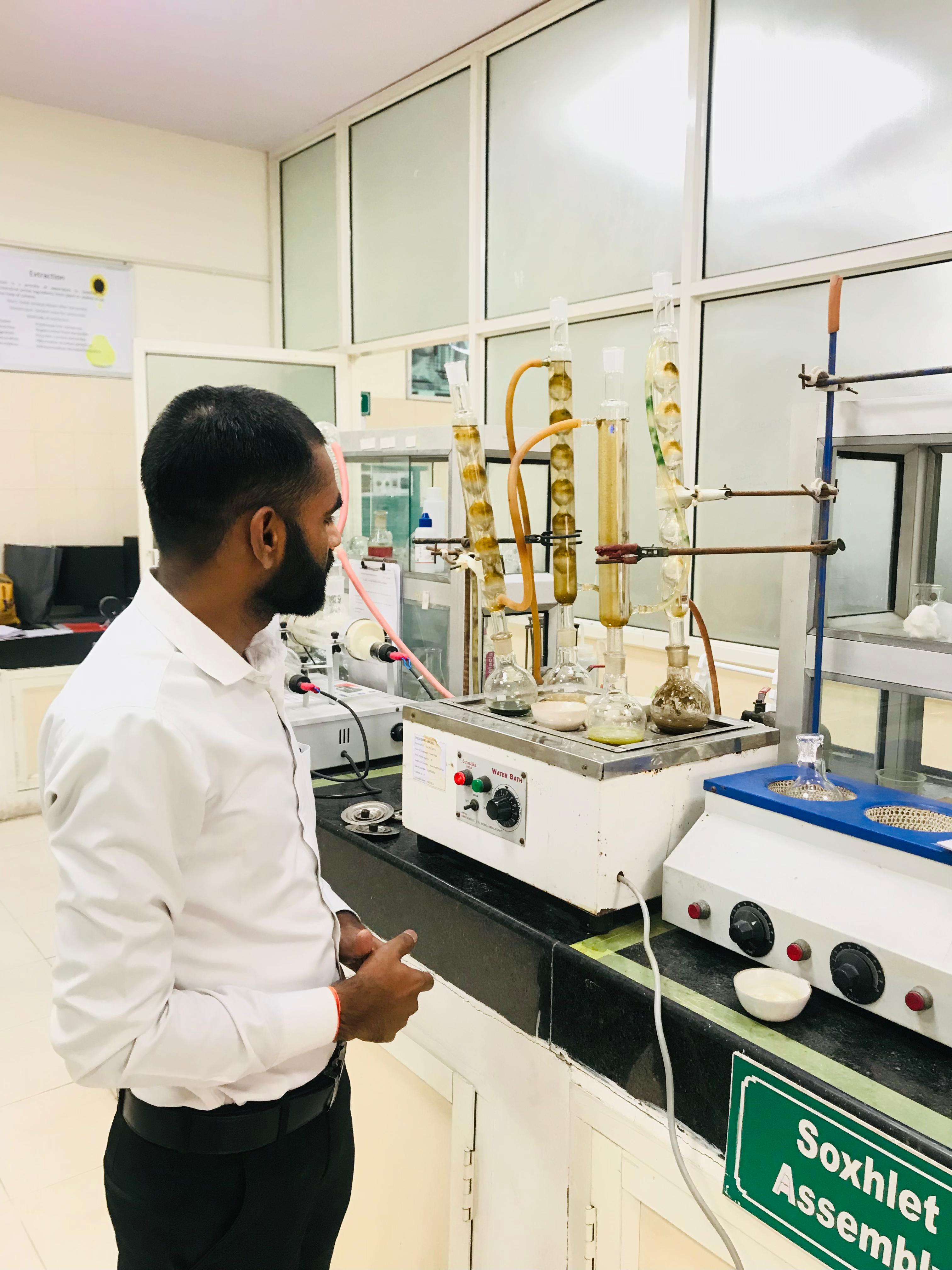Ijraset Journal For Research in Applied Science and Engineering Technology
- Home / Ijraset
- On This Page
- Abstract
- Introduction
- Conclusion
- References
- Copyright
Effect of Herbal Kunapajala and Different Organic Manures on Plant Growth, Quality and Yield of Withania Somnifera L. Dunal
Authors: Kheta Ram, Prof. Aku Ramamurthy, Prof. Sumit Nathani, Dr. Tarun Sharma, Surendra Kumar Yadav
DOI Link: https://doi.org/10.22214/ijraset.2024.62018
Certificate: View Certificate
Abstract
Cultivation of medicinal plants, especially high value medicinal plants is creating new dimension in the field of agriculture. The need for developing countries to acquire technologies and techniques for programmed cultivation of medicinal plants is a current issue. Ashwagandha, the 3rd important prioritized medicinal plant listed by National Medicinal Plant Board (NMPB) is also known as Indian Ginseng. Herbal medicines strongly involve mass appeal being safer and inexpensive. The traditional use of ‘Ashwagandha was to increase energy, youthful vigour, endurance, strength, health, nurture the time elements of the body, increase vital fluids, muscle fat, blood, lymph, semen and cell production. The total alkaloid content in the roots of the Indian types has been reported to vary between 0.13 and 0.31%, though much higher yields (upto to 4.3%) have been recorded elsewhere. In all, 13 components have been obtained chromatographically. Herbal kunapajala can be used as nutrient supplement at any growth stage of crop plant. The effectiveness of herbal kunapajala is due to the breakdown of complex compounds in to lower molecular weight compounds during the fermentation of ingredients and this make available nutrients to the plants. So, this study is planned to evaluate the effect of herbal kunapajala and organic manure on ashwagandha.
Introduction
I. INTRODUCATION
Medicinal plant cultivation is becoming a tool for diversification of Indian agriculture as many farmers have been looking for some better alternative to diversify from traditional agriculture due to gradual reduction in profit, decline in productivity and increased incidence of diseases and pests. Cultivation of medicinal plants, especially high value medicinal plants is creating new dimension in the field of agriculture. The need for developing countries to acquire technologies and techniques for programmed cultivation of medicinal plants is a current issue. There is a need for a scientific approach for propagation of medicinal plants and to collect relevant information regarding agro-technology, genuine planting material, economics of field cultivation, high yielding varieties etc. Indian farmers are facing various problems in cultivation of medicinal plants because lack of reliable and standardized technology package, lack of planting materials, market potential and system, cultivated vs. wild plants, organic farming techniques, and high fees for packages developed by various organizations etc. Ashwagandha is best suited for organic farming due to their lower nutritional requirements. Ashwagandha, the 3rd important prioritized medicinal plant listed by National Medicinal Plant Board (NMPB) is also known as Indian Ginseng. Herbal medicines strongly involve mass appeal being safer and inexpensive[1]. An esteemed Rishi (sage) Punarvasu Atriya was the first person who gave the teaching regarding the use of ashwagandha that extends back over 3000 to 4000 years ago wherein its use is widely extolled as a tonic particularly for emaciation in all age group of people. Ashwagandha is a small woody shrub or herb that grows or reaches about 30-75 cm in height. It belongs to the family Solanaceae having chromosome number 2n=48. It is an erect growing dicotyledonous evergreen shrub plant with fleshy long tap roots, found throughout the drier parts of India in waste places and on bunds[2]. The stem and branches are covered with minute stellate hairs. Leaves are simple upto 10 cm long, ovate, pedicillate and alternate. Plant bears small (1cm long), greenish or yellow flowers borne together in short axillary clusters. The fruits or berries are smooth. spherical, yellow, red coloured with 6 mm diameter enclosed in an inflated and membranous calyx. The fruit has small kidney shaped yellow coloured seeds (Nigam and Kandalkar, 1995)[3]. Ashwagandha is native to Mediterranean region in North Africa. It is found wild in grazing grounds in Jaipur and forestlands in the Rajasthan, all over the foothills of the Punjab and Himachal Pradesh and Western Uttar Pradesh, in the Himalayas.
Other than India, it is also found in the wild in the Mediterranean region in North Africa, Spain, Morocco, Jordan, Baluchistan (Pakistan), Sri Lanka[4]. The crop is cultivated in an area of about 14 thousand ha (approx.) in India, mainly in the drier parts of Madhya Pradesh, Punjab, Sind, Rajasthan and South India. Ashwagandha (Withania somnifera (L.) Dunal) is a well-known herb possessing several health benefits such as improve immune system, helps in lowering cholesterol, helps in regulating blood sugar level, stimulates collagen and promotes wound healing, reduces depression and stress, increase muscles mass and strength and reducing swelling and pain. It improves learning ability and memory capacity. The traditional use of ‘Ashwagandha was to increase energy, youthful vigour, endurance, strength, health, nurture the time elements of the body, increase vital fluids, muscle fat, blood, lymph, semen and cell production[5]. The total alkaloid content in the roots of the Indian types has been reported to vary between 0.13 and 0.31%, though much higher yields (upto to 4.3%) have been recorded elsewhere. In all, 13 components have been obtained chromatographically. This includes choline, tropanol, pseudotropanol, cuscopygrene. 3-tigloyloxytropana, isopellatierine, anaferine, anahygrine. Withasomnine and several other steroidal lactones. In addition to the alkaloids, the roots are reported to contain starch, reducing sugars, hentriacontane, glycosides, dulcitol, withanicil (0.08%), an acid and a neutral compound[6]. In addition, the leaves are reported to contain five unidentified alkaloids (yield 0.09%), withanolides, glycosides, glucose and many free amino acids. The occurrence of chlorogenic acid, condensed tannin (also in the stems) and flavonoid are also reported (The Wealth of India, 2004)[7]. The fully decomposed nutrient of Herbal kunapjala are more readily available to plant nutrition as well plant protection , The performance of Vrikshayurveda –based nettle based Herbal kunapjala technology will be tested in various crops and crop rotation at NEB crop Research Center , Horticulture Research Center , floriculture Research Center and Vegetable Research Center at GBPUA&T Pantnagar.
II. MATERIALS AND METHODS
A. Experimental Details
Location : Field & laboratory, Department of Vrikshayurveda NIA Jaipur.
|
Name of crop |
: |
Ashwagandha (Withania somnifera L. Dunal) |
|
Season |
: |
Rabi, 2023 - 24 |
|
Experimental design |
: |
Randomized Block Design (RBD) |
|
Name of cultivars |
: |
JA-134 |
|
Number of treatments |
: |
08 |
|
Number of replications |
: |
03 |
|
Total number of plots |
: |
24 |
|
Net plot size |
: |
2.70 m x 1.80 m = 4.86 m2 |
|
Spacing |
: |
45 x 30 (RXP) cm |
|
Total number of plants |
: |
864 plants |
|
Gross area of experiment |
: |
151.04 m2 |
|
Distance between replication |
: |
1 m |
|
Distance between plots |
: |
0.5 m |
|
Date of planting |
: |
7th October 2023 |

Good Agricultural practices:-
- Field preparation
The experimental area was ploughed twice with the help of tractor drawn implements in both directions and harrowing was done to break the clods and leveling was done.
- Manures and fertilizers
Full dose of FYM (farm yard manure) and vermicopost was applied one week before sowing and mixed well. Kunapajala was applied to experimental plots at the rate of three per cent at fifteen days’ interval up to harvest of crop.
- Sowing of seed
Ashwagandha seeds were sown on 7th October 2023 in ridge and furrow. The seeds were sown @ 10-12 kg ha. The distance between rows was kept 45 cm, whereas between plants 30 cm distance was maintained by removing the plants in lines manually.
- Irrigation
In the field of ashwagandha crop irrigation is required for proper vegetation. Growth, root formation and also to maintain proper alkaloid, so first irrigation was applied just after sowing and five irrigations were given at 15 days’ interval during the crop growth period.
- Weeding
Weeding of ashwagandha field is very important because weeds cause incredible losses of economical part of ashwagansha and complete for nutrient, light, etc. Weeding cum hoeing was done manually at 20 and 35 DAS. The important weed flora was observed during crop period like major and minor weed flora such as grasses and Cuscuta reflexa, Chanopodium album, Iridex procumbensa.
The plot soil was treated with Trichoderma harzianum for protection from fungal infection. To prevent aphid infestation, the plants were sprayed with Neem oil 1.5 ml/liter of water. No other serious pest and disease incidence was noticed throughout the crop growth period.
- Harvesting
In experimental field of ashwagandha crop harvesting is done manually on 15th April 2024. The crop was harvested at maturity stage according to medicinal plant maturity indicator, physical analysis such as yellowing, drying and cracking of berries accompanied with drying of leaves was seen in standing crop. 24 hours Before harvesting the crop light irrigation was given, so that the plant is removed with full root system. After removing the whole plant, the root was cut from the stem initiation portion. Each bunch of root was washed with water to remove the soil and kept for sun drying.
- Yield
Experimental crop of ashwagandha was harvested separately for Root yield and Seed yield.
III. EXPERIMENTAL RESULTS
Results of the field experiment, entitled “Effect of Herbal Kunapajala and different organic manures on Plant growth, quality and yield of Withania somnifera L. Dunal.” conducted at the field and laboratory, Department of Vrikshayurveda NIA Jaipur in Rabi season of 2023- 2024 in randomized block design with three replications and the experiment was comprised with eight different level of herbal kunapajala and different organic manures, are presented and described in this chapter. Data pertaining to various criteria used for treatments evaluation were analyzed statistically to test their significance and analysis of variance for these data has been furnished in appendices. Interpretation of data has been made on the mean basis, highlighting the significant effect of treatments. The results for all treatments are presented in succeeding paragraphs.
A. Growth Parameters
Growth of ashwagandha crop was evaluated in respect of plant height (cm), number of leaves (plant-1), number of branches (plant-1), fresh weight of plants (g), dry weight of plants (g), leaf area (cm 2 plant-1), leaf area index were noted at 45, 90, 135 DAS and at harvest stage. The data recorded at different stages of growth are presented as follows:
- Plant height (cm plant -1)
The significant differences were exhibited among the different doses of herbal kunapajala, FYM and vermicompost for plant height during the biological hours of plant growth and data are presented in Table 4.1 and graphically illustrated in Fig.4.1.
At 45 DAS
The result revealed that the T8 - Kunapajala @ 3000 L/ha + Vermicompost @ 6t/ha + FYM @ 10t/ha recorded the plant height of 15.45 cm at 45 DAS (days after sowing) which was significantly higher and was followed by T6 – Kunapajala @ 3000 L/ha + FYM @ 10t/ha (14.39 cm). However, minimum plant height (8.40 cm) was observed under T1 - Control.
At 90 DAS
A perusal of data indicated the significantly maximum plant height (31.33 cm) was recorded under the treatment T8 – Kunapajala @ 3000 L/ha + Vermicompost @ 6t/ha + FYM @ 10t/ha which was followed by T7 – Vermicompost @ 6t/ha + FYM @ 10t/ha (30.67 cm) over rest of the treatments. However, the minimum plant height (23.00 cm) was observed in T1 –control at 90 DAS.
At 135 DAS
The different combination of herbal kunapajala, FYM and vermicompost were showed significantly on plant height at 135 DAS. The plant height were recorded highest (46.33 cm) under the treatment T8 – Kunapajala @ 3000 L/ha + Vermicompost @ 6t/ha + FYM @ 10t/ha, followed by T7 – Vermicompost @ 6t/ha + FYM @ 10t/ha. However, the minimum plant height (36.67 cm) was observed under treatment T1 -control.
At haevest
The result shows slow growth after 135 DAS to harvest. The plant produced from treatment T8 – Kunapajala @ 3000 L/ha + Vermicompost @ 6t/ha + FYM @ 10t/ha was recorded maximum plant height (48.12 cm) which was followed by T7 – Vermicompost @ 6t/ha + FYM @ 10t/ha and the plant produced from treatment T1 –control shorter in height (37.07 cm) among all the treatment.


Chromatography – TLC&HPTLC
The HPTLC analysis performed on roots is shown in Fig. 6. In the methanolic extracts of roots, bands were identified under the sources of UV 366 nm, UV 254 nm, and after derivatization with p-Anisaldehyde sulphuric acid reagent revealing the presence of differences in the bands. The methanolic extracts of roots produced one fluorescent blue, one blue and one band of red at 366 nm.
Three grey and three fluorescent grey bands at 254 nm. After derivatization with p-Anisaldehyde sulphuric acid reagent shown one pale purple, five violet, one dark violet and three light violet bond in root powder of T8.
Conclusion
On the basis of one year research and the results reported above it could be concluded that the different combination herbal kunapajala and organic manures significantly and non-significantly influenced the growth and yield attributes of ashwagandha. Hence, out of eight treatments T8 – Kunapajala @ 3000 L/ha + Vermicompost @ 6t/ha + FYM @ 10t/ha was best comprises for enhanced growth and yield of ashwagandha.
References
[1] Ahmed, H.A. and El-Darier, S.M. (2024) Phytochemistry, allelopathy and anticancer potentiality of Withania somnifera (L.) Dunal (Solanaceae). Brazilian Journal of Biology, , vol. 84, e263815. [2] Ajay, P., Ramesh, K., Reddy, S., Ramana, S. and Maji, B. (2005). Effect of nitrogen and farm yard manure of physiological parameters in ashwagandha under vertisol soil type. Ind. J. Plant Physio., 10(4): 389-393. [3] Altemimi A., Lakhssassi N., Baharlouei A., Watson D. and Lightfoot D. (2017). Phytochemicals: Extraction, Isolation, and Identification of Bioactive Compounds from Plant Extracts. Plants 6:1–23. [4] Arasu, P. A. and Ponnuswami, V. (2010) Effect of pre harvest foliar sprays of bio stimulants and mineral nutrients on improving yield potential in periwinkle (Catharanthus roseus L.). Res. On Crops, 11(2): 521-527. [5] Azarmi, Ziveh R., Satari P. S. and M. R. (2008) Effect of vermicompost on growth, yield and nutrition status of tomato (Lycopersicum esculentum). Pakistan Journal of Biological Sciences 11: 14, 1797-1802. [6] Banavath Mahesh Naik, Sunita T Pandey, Subhash Chandra, Amit Bhatnagar, Rajeev Kumar and Navneet Praeek (2022). Effect of liquid fermented organic manure (Herbal kunapajala) concoctions and their doses on chlorophyll content of mustard crop at Pantnagar, India. The Pharma Innovation Journal; 11(8): 720-724. [7] Basak, B.B.; Saha , A.; Gajbhiye, N.A.; and Manivel P. (2020). A Potential of organic nutrient sources for improving yield and bioactive principle of Ashwagandha (Withania somnifera) through Enhanced soil Fertility and Biological Functions. Comm. in Soil sci. Plant Analysis. 51(6):779–793.
Copyright
Copyright © 2024 Kheta Ram, Prof. Aku Ramamurthy, Prof. Sumit Nathani, Dr. Tarun Sharma, Surendra Kumar Yadav. This is an open access article distributed under the Creative Commons Attribution License, which permits unrestricted use, distribution, and reproduction in any medium, provided the original work is properly cited.

Download Paper
Paper Id : IJRASET62018
Publish Date : 2024-05-12
ISSN : 2321-9653
Publisher Name : IJRASET
DOI Link : Click Here
 Submit Paper Online
Submit Paper Online

